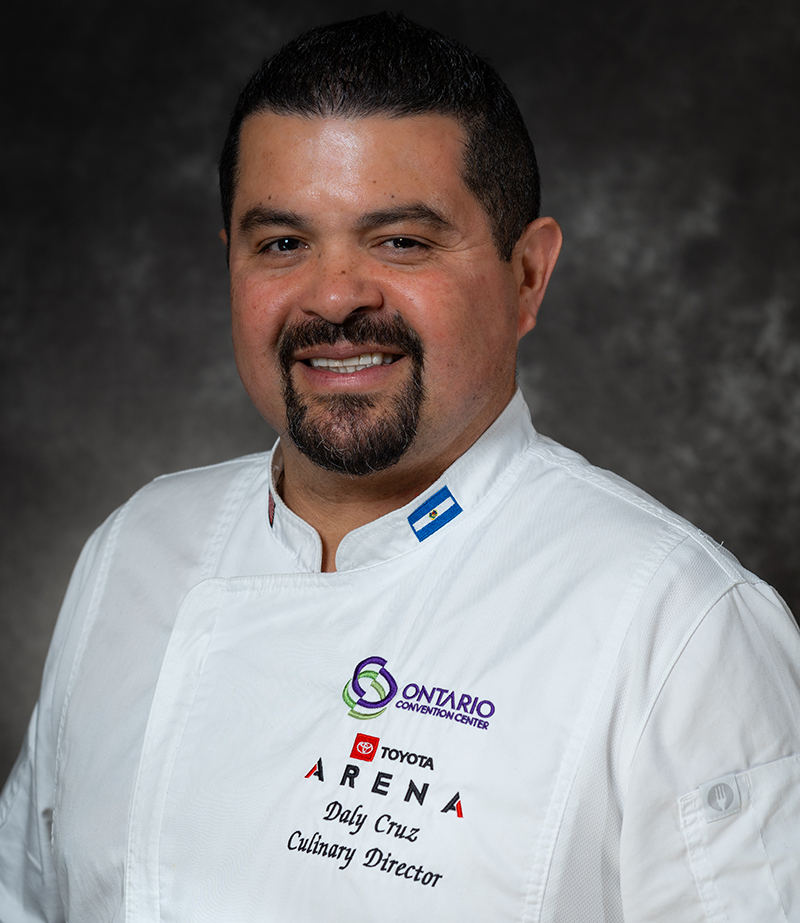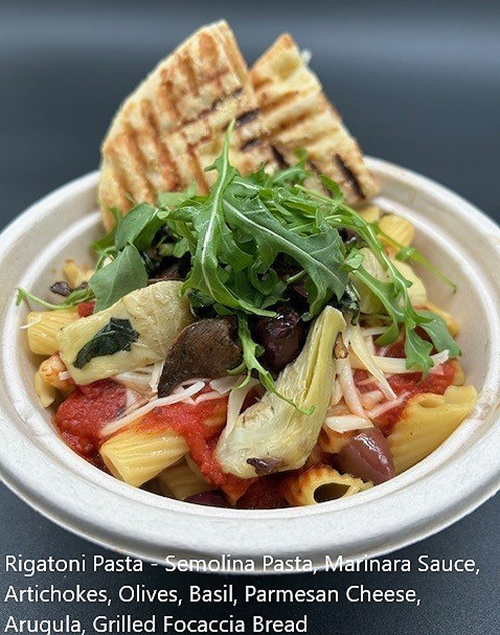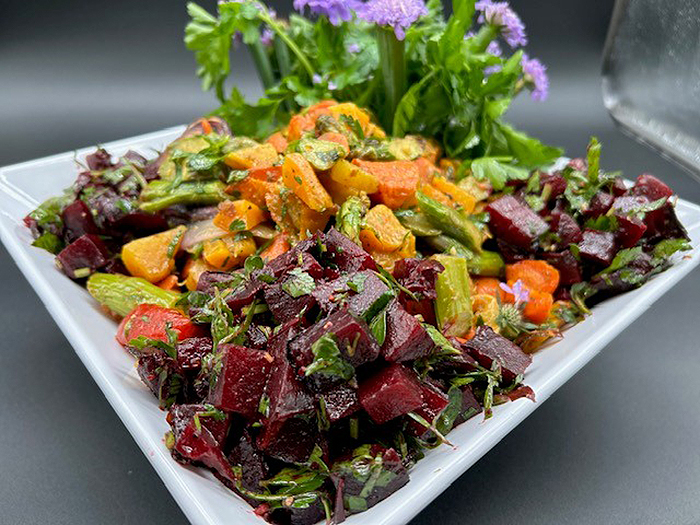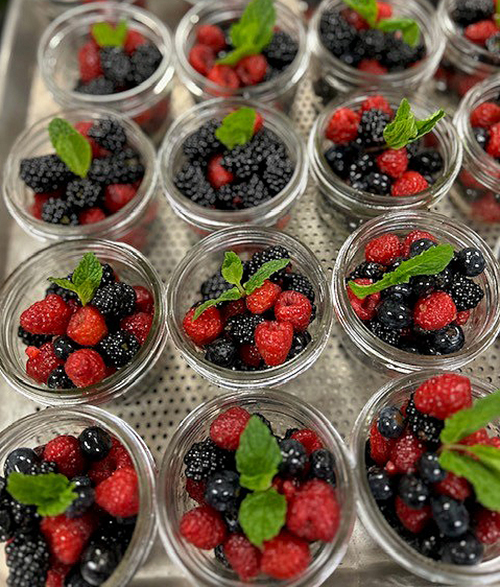Taste Trends: 5 Chefs Share Sustainable F&B Strategies for Corporate Events

Sustainability is increasingly becoming a driving force behind the way corporate events are planned and executed, and food and beverage (F&B) is taking center stage as a key opportunity for planners to reduce the environmental impact of their events. From sourcing local, seasonal ingredients and plant-forward menus to minimizing food waste and reducing single-use serve and serviceware, sustainable F&B practices can significantly contribute to an event’s overall eco-footprint.
So how can corporate event planners work with their venue’s culinary team to bring sustainability to the forefront of their event F&B offerings? We consulted with several executive chefs and culinary directors at five major ASM Global convention centers throughout the U.S. to learn their best practices for how events can leverage the expertise of in-house chefs to incorporate planet-friendly menus that are not only memorable and delicious but also environmentally responsible.
Meet the F&B experts we consulted:
- Chef Daly Cruz, executive chef, Ontario Convention Center, Ontario, Calif.
- Joshua Moore, executive chef, OKC Convention Center, Oklahoma City
- Chef Jesus Cibrian, director of culinary, Long Beach Convention & Entertainment Center, Long Beach, Calif.
- Bhavesh Patel, executive chef, Broward County Convention Center, Fort Lauderdale, Fla.
- Chef David Teig, director of culinary services, Moscone Center, San Francisco
Savas: How can event planners collaborate with convention center culinary teams to maximize F&B sustainability?

Cruz: Event planners can enhance sustainability by collaborating with culinary teams to build flexible, seasonal menus. One effective approach is to select a core protein and allow the chef to create a ‘Chef’s Selection’ of locally sourced accompaniments. This gives chefs the freedom to use the freshest, most cost-effective ingredients available, reducing environmental impact and staying within budget. It’s a simple yet impactful way to support local farms, reduce waste, and deliver a thoughtful, high-quality dining experience.
Moore: It’s important to begin the planning process early. Sharing menu requests, budget, and sustainability goals upfront helps everyone align from the start. We focus on using locally sourced ingredients throughout the menu wherever possible. One approach is to keep some menu items flexible, using terms like “seasonal vegetables” or “seasonal salad,” which allows us to highlight what’s available at the time of the event.
Cibrian: Meeting with the client and understanding the group and event are key to creating sustainable menus. It’s also super important to have a strong relationship with the local vendors— their insight into seasonal availability of ingredients helps us stay within the meeting planner’s budget.
 Patel: Event planners and convention center culinary teams can significantly reduce environmental impact by working together with intention. Starting the conversation early means a better sustainability strategy, especially when goals like local sourcing, minimizing food waste, or featuring plant-based menus are aligned upfront. Being transparent with budgets upfront allows chefs to propose creative solutions that still work within financial limits.
Patel: Event planners and convention center culinary teams can significantly reduce environmental impact by working together with intention. Starting the conversation early means a better sustainability strategy, especially when goals like local sourcing, minimizing food waste, or featuring plant-based menus are aligned upfront. Being transparent with budgets upfront allows chefs to propose creative solutions that still work within financial limits.
Building seasonal menus and tapping into regional specialties not only reduces transportation emissions but also supports local farmers and vendors—planners can even ask for “hyper-local” options. Flexible, “chef’s choice” menus allow culinary teams to design dishes based on ingredients that are fresh and cost-effective, and going plant-forward with vegetarian and vegan dishes helps lower the carbon footprint while being budget-friendly, too. Blending proteins, such as using meat as a flavor accent rather than the star (e.g., mushroom-beef burgers or small meat portions with lots of vegetables), also supports more sustainable dining.
Minimizing food waste through accurate headcounts, rethinking portion sizes, and donating leftovers to local charities (when possible) is key. Whenever you can, choose reusable or compostable serveware, serve beverages from dispensers instead of individual bottles or cans, and set up water refill stations to help reduce service and packaging waste. Telling your event’s sustainability story through signage to showcase local farms, seasonal ingredients, or zero-waste strategies, and offering interactive stations like “farm-to-table tastings” or “build-your-own” bowls using sustainable ingredients can all help engage attendees and elevate the event experience. And when it comes to budget-smart strategies, avoid premium “greenwashed” options, ask about bulk deals or surplus ingredients, and keep menus simple.

Teig: A large percentage of our events feature custom menus, and we do our best to highlight seasonal ingredients, especially those sourced in northern California. When working with event organizers, we consider the timing of each event to incorporate what is local and in-season. For example, menus in April and May are ideal for showcasing San Joaquin Delta asparagus, and June is stone fruit season in NorCal. We want our guests and clients to experience the best ingredients each season has to offer.
Savas: What are some best practices or strategies you recommend to planners for minimizing food waste during large-scale events?
Cruz: We recommend staffed buffets rather than self-serve, as this allows our team to manage portion sizes and gives the culinary team better control over how much food is prepared. By reducing overproduction and ensuring guests receive just what they need, we can significantly cut down on waste while still delivering a seamless and satisfying dining experience.
Moore: It’s important to stick to the timelines for providing accurate guest counts. Give us day-of counts even if they may be under your guarantee, so we can reduce waste. Three other tips: allow us to plate live to control portion size for your guests; use composting trash cans and plan for them to be monitored so food can be properly donated; and make sure staff is trained in all our [sustainability] practices.

Cibrian: One of the best ways to reduce food waste is to set up proper production forecasting for the event. Also, try to incorporate action stations, allowing chefs to cook fresh items as needed, and, whenever possible, portion control the food, as guests will often put more food on their plate than they can eat. Donate any extra to a food bank or soup kitchen.
Patel: Minimizing food waste at large-scale events is crucial for sustainability and cost-efficiency. Our best practices for planners include:
- Accurate guest counts: Use historical data and RSVP systems to estimate attendance accurately, reducing over-preparation.
- Flexible menu planning: Design menus that allow for ingredient cross-utilization across dishes, minimizing unused items.
- Portion control: Serve appropriate portion sizes to reduce waste.
- Real-time monitoring: Implement systems to track food consumption during the event, allowing for on-the-fly adjustments.
- Donation programs: Partner with local organizations to donate surplus food, ensuring it benefits the community instead of going to waste.
- Composting and recycling: Set up clearly marked bins for compostable and recyclable materials and educate attendees on proper disposal.
- Staff training: Ensure all staff are trained in waste reduction practices, from kitchen prep to cleanup.
Teig: As a baseline standard, we only use compostable single-use containers for our events. This is a key topic we discuss with event planners and clients at site visits and pre-con meetings. Our efforts to divert waste from landfills are significant, though it can come as somewhat of an added expense to us. We work closely with our waste hauler to ensure proper composting. In some cases, we take the extra step of labeling compostable items with stickers to make them easy to identify.
We also have a robust food-donation program in partnership with local non-profits to ensure surplus food is redirected to people and groups in need. For example, in the first quarter of 2025, we donated 24,374 pounds of food from our events. In California, these donations also keep us in compliance with California State Bill 1383, which, among other sustainability mandates, requires that businesses donate surplus edible food and track the donations.
Savas: What are some of the most popular plant-forward dishes you’re currently serving at your venue? Please describe and make us hungry in the process.
Cruz: One of our crowd favorites, the Soy Chorizo Vegan Nachos, is a standout plant-forward option at our concessions. Crisp tortilla chips are layered with our creamy house-made vegan cheese sauce, savory soy chorizo, fresh guacamole, and vibrant pico de gallo. Bold, satisfying, and packed with flavor, it’s proof that plant-based meals can be just as crave-worthy as the classics.
Moore: One popular dish is polenta cake with white bean ratatouille, which is served with sauteed garlic, onions, white beans, and tomatoes. It’s deglazed with white wine and finished with tomato sauce, broccolini tops, and fresh basil. Another hit is our vegan gluten-free carrot cake with pineapple, topped with vegan cream cheese icing and candied dried carrot.

Cibrian: When we create a menu, we always try to have a balance of plant-based items and proteins. One plant-forward menu item that people enjoy is our Grilled Vegetable Terrine. It layers open-flame grilled asparagus, zucchinis, and squash with thin slices of Yukon potatoes, wild mushrooms, baby spinach, and shaved local cheese, and is served with pimentos coulis and black garlic sauce. Another popular dish is our Saffron Confit Fennel, which has bulb fennel simmered in olive oil, saffron, fresh dill, served with potato puree, green beans, and seasonal baby carrots.
Patel: Grilled Vegetable and Quinoa Salad: A vibrant mix of grilled seasonal vegetables like zucchini, bell peppers, and eggplant, served over a bed of fluffy quinoa. Tossed with a light lemon-herb vinaigrette and garnished with fresh herbs, this salad is both hearty and refreshing.

Whole-Wheat Pasta Primavera: Whole-wheat pasta tossed with a medley of sautéed vegetables such as broccoli, cherry tomatoes, and spinach in a garlic-infused olive oil sauce. Finished with a sprinkle of nutritional yeast for a cheesy flavor without the dairy.
Jackfruit Tacos: Tender jackfruit seasoned with smoky spices, served in soft corn tortillas and topped with avocado slices, pickled red onions, and a drizzle of vegan crema. These tacos offer a satisfying, meaty texture that’s entirely plant based.
Vegan Chocolate Avocado Mousse: A decadent dessert made by blending ripe avocados with dark cocoa powder and a touch of maple syrup, resulting in a creamy, rich mousse that’s both indulgent and healthy.
Teig: On one hand, we’re focused on highlighting plant-forward foods; on the other, we recognize that animal protein is part of the diet of a large majority of our guests. To reflect this, we recently re-wrote our catering menus to create more options. For example, our selection of 12 hot and cold lunch bowls are all either vegan or vegetarian. Guests can choose from a range of animal protein add-ons, but we start from a plant-forward foundation to give a wide variety of options.
Lead image: Chef Cibrian, Long Beach Convention & Entertainment Center. All food images courtesy of Long Beach Convention & Entertainment Center.
Don’t miss any event-related news: Sign up for our weekly e-newsletter HERE, listen to our latest podcast HERE and engage with us on Twitter, Facebook and LinkedIn!


Add new comment